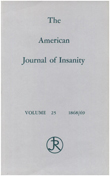Evaluating the spectrum concept of schizophrenia in the Roscommon Family Study
Abstract
OBJECTIVE: The authors sought to evaluate whether the pattern of schizophrenia and related disorders in probands and their relatives can be explained by a single underlying continuum of liability to the "schizophrenia spectrum." METHOD: In the epidemiologically based Roscommon Family Study, the authors separately examined--in siblings, parents, and relatives of index and comparison probands--the familial aggregation and coaggregation of five hierarchically defined disorders: schizophrenia, schizoaffective disorder, schizotypal/paranoid personality disorder, other nonaffective psychoses, and psychotic affective illness. A multiple threshold model was fitted to these contingency tables by maximum likelihood. RESULTS: The multiple threshold model that constrained resemblance to be the same in siblings and parents fit the data well and estimated the correlation in liability to schizophrenia spectrum disorders between probands and first-degree relatives at 0.36. Parents, however, required higher levels of liability to manifest schizophrenia spectrum disorders than siblings. While schizophrenia and psychotic affective illness could be clearly assigned to the two extremes of the schizophrenia spectrum, the proper ordering of schizoaffective disorder, schizotypal/paranoid personality disorder, and other nonaffective psychoses could not be unambiguously determined. CONCLUSIONS: These results are consistent with the existence of a schizophrenia spectrum in which these five disorders are manifestations, of varying severity, of the same underlying vulnerability. This vulnerability is strongly transmitted within families.
Access content
To read the fulltext, please use one of the options below to sign in or purchase access.- Personal login
- Institutional Login
- Sign in via OpenAthens
- Register for access
-
Please login/register if you wish to pair your device and check access availability.
Not a subscriber?
PsychiatryOnline subscription options offer access to the DSM-5 library, books, journals, CME, and patient resources. This all-in-one virtual library provides psychiatrists and mental health professionals with key resources for diagnosis, treatment, research, and professional development.
Need more help? PsychiatryOnline Customer Service may be reached by emailing [email protected] or by calling 800-368-5777 (in the U.S.) or 703-907-7322 (outside the U.S.).



